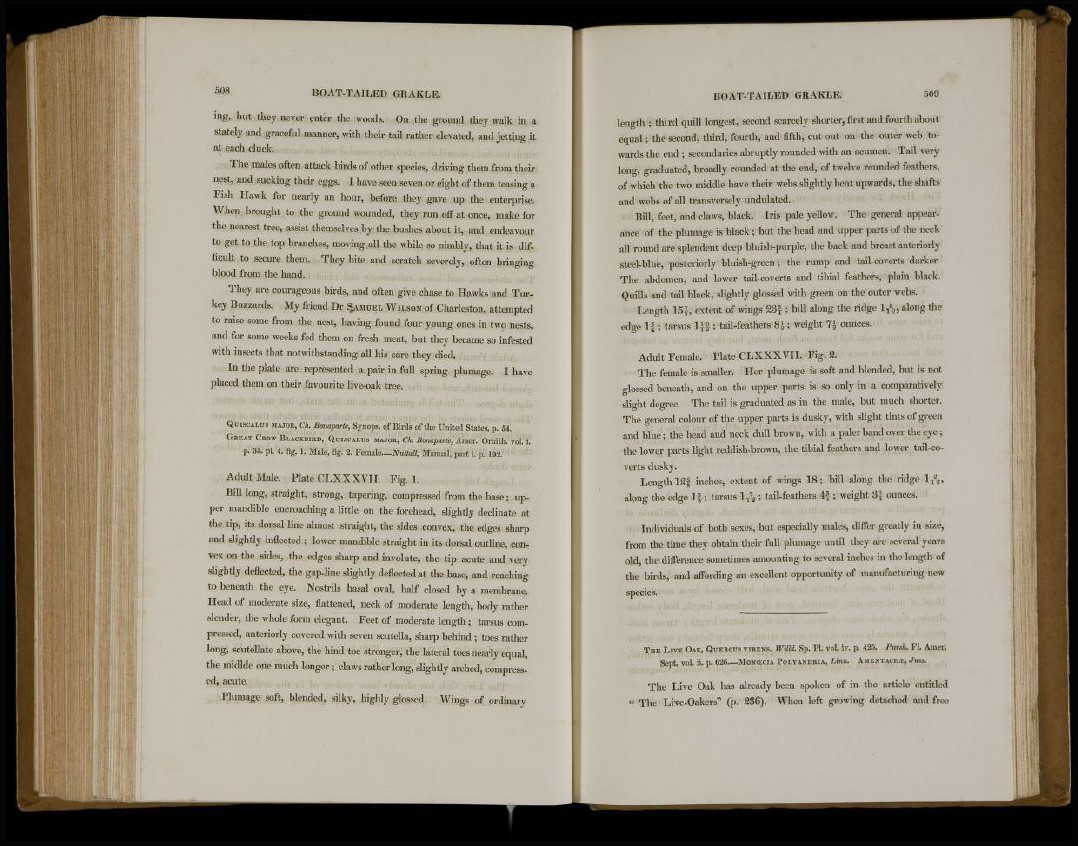
ing, but tbey never enter the woods. On the ground they walk in a
stately and graceful manner, with their tail rather elevated, and jetting it
at each cluck.
The males often attack birds of other species, driving them from their
nest, and sucking their eggs. I have seen seven or eight of them teasing a
Fish Hawk for nearly an hour, before they gave up the enterprise.
When brought to the ground wounded, they run off at once, make for
the nearest tree, assist themselves by the bushes about it, and endeavour
to get to the top branches, moving all the while so nimbly, that it is difficult
to secure them. They bite and scratch severely, often bringing
blood from the hand.
They are courageous birds, and often give chase to Ha.wks and Turkey
Buzzards. My friend Dr ^AMUEL WILSON of Charleston, attempted
to raise some from the nest, having found four young ones in two nests,
and for some weeks fed them on fresh meat, but they became so infested
with insects that notwithstanding all his care they died.
In the plate are represented a pair in full spring plumage. I have
placed them on their favourite live-oak tree.
QUISCALUS MAJOR, Ch. Bonaparte, Synops. of Birds of the United States, p. 54.
GREAT CROW BLACKBIRD, QUISCALUS MAJOR, Ch. Bonaparte, Amer. Ornith. vol. i.
p. 35. pL 4. fig. 1. Male, fig. 2. Female—Nultall, Manual, part i. p. 192.
Adult Male. Plate CLXXXVII. Fig. 1.
Bill long, straight, strong, tapering, compressed from the base; upper
mandible encroaching a little on the forehead, slightly declinate at
the tip, its dorsal line almost straight, the sides convex, the edges sharp
and slightly inflected ; lower mandible straight in its dorsal outline, convex
on the sides, the edges sharp and involute, the tip acute and very
slightly deflected, the gap-line slightly deflected at the base, and reaching
to beneath the eye. Nostrils basal oval, half closed by a membrane.
Head of moderate size, flattened, neck of moderate length, body rather
slender, the whole form elegant. Feet of moderate length; tarsus compressed,
anteriorly covered with seven scutella, sharp behind ; toes rather
long, scutellate above, the hind toe stronger, the lateral toes nearly equal,
the midlde one much longer ; claws rather long, slightly arched, compressed,
acute.
Plumage soft, blended, silky, highly glossed. Wings of ordinary
length ; third quill longest, second scarcely shorter, first and fourth about
equal; the second, third, fourth, and fifth, cut out on the outer web towards
the end ; secondaries abruptly rounded with an acumen. Tail very
long, graduated, broadly rounded at the end, of twelve rounded feathers,
of which the two middle have their webs slightly bent upwards, the shafts
and webs of all transversely undulated.
Bill, feet, and claws, black. Iris pale yellow. The general appearance
of the plumage is black ; but the head and upper parts of the neck
all round are splendent deep bluish-purple, the back and breast anteriorly
steel-blue, posteriorly bluish-green ; the rump and tail-coverts darker.
The abdomen, and lower tail-coverts and tibial feathers, plain black.
Quills and tail black, slightly glossed with green on the outer webs.
Length 15^, extent of wings 2 3 | ; bill along the ridge 1T
6
2 , along the
edge I f ; tarsus 1}§ ; tail-feathers 8}2; weight 7£ ounces.
Adult Female. Plate CLXXXVII. Fig. %
The female is smaller. Her plumage is soft and blended, but is not
glossed beneath, and on the upper parts is so only in a comparatively
slight degree. The tail is graduated as in the male, but much shorter.
The general colour of the upper parts is dusky, with slight tints of green
and blue; the head and neck dull brown, with a paler band over the eye;
the lower parts light reddish-brown, the tibial feathers and lower tail-coverts
dusky.
Length 12f inches, extent of wings 18; bill along the ridge l T
2
g ,
along the edge 1§; tarsus l T
7
g ; tail-feathers 4 | ; weight 3^ ounces.
Individuals of both sexes, but especially males, differ greatly in size,
from the time they obtain their full plumage until they are several years
old, the difference sometimes amounting to several inches in the length of
the birds, and affording an excellent opportunity of manufacturing new
species.
THE LIVE OAK, QUERCUS VIRENS, Willd. Sp. PI. vol iv. p. 425. Pursh, FL Amer.
Sept. vol. ii. p. 626 MONOSCIA POLYANDRIA, Linn. AMENTACEJE, JUSS.
The Live Oak has already been spoken of in the article entitled
« The Live-Oakers" (p. 236). When left growing detached and free